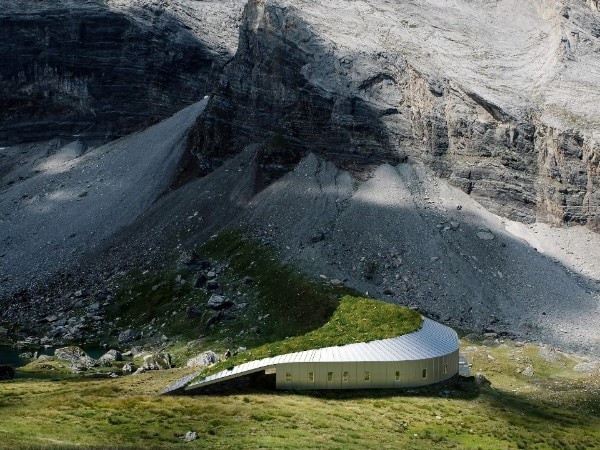Snøhetta presents a new project, in line with the approach that has characterised the studio's work for years and that translates into a constant attempt to interpret the authentic meaning of “environment” and to resolve the complex relationship between the natural and anthropic landscape.
Refuge de Barroude, in the heart of the Pyrenees National Park – a UNESCO World Heritage site – will offer a resting place for hikers on the Haute Route des Pyrénées, as well as a reception and support centre for the Park's staff, replacing the old building destroyed by fire a decade ago.
The intervention fits “on tiptoe” into the majestic mountain landscape, almost crouching into the topography but renouncing any mimetic rhetoric, in a delicate balance between integration into the context and legibility of the built work.

The building sits on the natural slope of the site, spreading over two levels without the need for impactful excavation work. The green roof follows the lines of the landscape and creates a lively contrast with the stone, wood and aluminium shell. Inside, two clearly identified but interconnected functional areas are located: on the one hand, the spaces open to the public with the reception areas, dining room, toilets and dormitories; on the other hand, the private spaces reserved for the refuge guardian and the Pyrenean National Park staff.
The building is a bioclimatic organism designed to minimise its ecological footprint. The compact shape significantly reduces energy consumption for heating and cooling, while the green roof provides high insulation. Efficient energy management, through photovoltaic panels to produce electricity and solar and biomass panels for heating and hot water, cuts dependence on fossil fuels and greenhouse gas emissions. The use of recycled (aluminium and wood) and locally sourced (stone) materials decreases carbon emissions and strengthens the link with the local building tradition.
The next phases of the project will start in 2025 with completion scheduled for 2027.
- Project:
- Refuge de Barroude
- Architectural project:
- Snøhetta
- Client:
- Parc national des Pyrénées
- Mechanical engineer:
- Energeco
- Structural engineer and Façade consultant:
- Bollinger + Grohmann
- Civil engineer:
- Prima Ingénierie

Metamorphosis: when ceramics lives with technology
Iris Ceramica Group presents "Metamorphosis" at Fuorisalone 2025, an experience that merges art and technology, featuring interactive installations and innovative surfaces.














